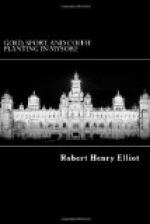Besides the first mentioned, and now abandoned coffee district, and the Bamboo district, there is the important district of North Coorg, which, though it has a smaller number of estates, certainly contains coffee that, so far as I am able to judge, it would be impossible to surpass.
There are, in all, at present in Coorg 130 European estates, with a total area of 32,323 acres (of which 20,000 are in the Bamboo district), and 6,207 native estates and gardens, aggregating in all 70,669 acres. The average production of coffee from all these sources is estimated by competent authorities at from 4,000 to 5,000 tons of coffee per annum, or of a probable annual value of from L250,000 to L300,000. The yield from a well cultivated estate averages from 3 to 4 cwt. of clean coffee per acre. Exceptional properties there are, of course, which give higher returns than this, and some could be quoted which give 6 to 7 cwt. on the average, while sensational figures might be quoted as regards some remarkable estates. But to give an account of such exceptional estates might convey a misleading idea of the general return to be obtained from coffee in Coorg, though I think it well to allude to the fact that better returns than those first mentioned can be obtained, and have been obtained, as it is always of value to know what particular pieces of land can do under the most favourable circumstances, as this opens up the important question as to whether it would not pay better to confine cultivation on an estate to a narrow area of the best soils and situations on it—a subject to which I shall more particularly refer later on in this chapter.




